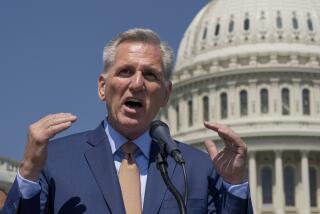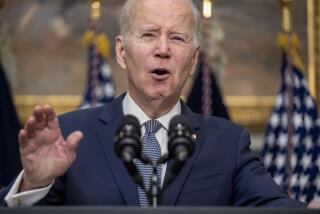Suddenly, those bailout buckets looked too small
- Share via
WASHINGTON — Early Thursday, Treasury Secretary Henry M. Paulson sipped Diet Coke in his office as four flat-screen computer monitors flashed the latest financial data from around the world.
For months, Paulson had been running from crisis to crisis, engineering rescues for disintegrating firms. Now a cataclysm was enveloping global markets, triggering a run on money market funds that had been considered safe. Paulson decided the U.S. government must intervene, and fast.
Federal Reserve Chairman Ben S. Bernanke had come to the same conclusion. They joined an 8:30 a.m. conference call with other policymakers to sketch out what would become the most sweeping public intervention into the private economy in recent U.S. history. They thought their plan could soothe the hysteria. But first, they had to sell it to Congress.
That decision led to a late-night meeting in the Capitol, where Paulson and Bernanke warned congressional leaders that they must act to prevent a global meltdown.
Democratic leaders vowed to approve legislation giving Treasury expansive new powers, but it remains unclear whether they have the votes.
The discussion of a broader market bailout, which could cost taxpayers at least $500 billion, began Monday as Treasury and Fed officials were working to rescue insurance giant American International Group.
This accounting draws from interviews with federal officials, lawmakers and congressional staffers who participated in the meetings. Many spoke on condition of anonymity because much of the discussions occurred in private meetings.
The government’s rescue of AIG on Tuesday hadn’t calmed the public’s nerves. There appeared to be a run developing on money market mutual funds, a $3.5-trillion pool of savings that was supposed to be as safe as cash, but lacks any government guarantee. If money market funds failed, ordinary people stood to lose huge sums. Meanwhile, shares of Morgan Stanley and Goldman Sachs Group sunk as investors bet they would collapse just as their rivals had. Commercial banks stopped lending to one another. The stock markets dived.
It was time to act. Bernanke leaned into the speakerphone. With New York Fed President Timothy Geithner and Securities and Exchange Commission Chairman Christopher Cox on the line, Bernanke said the government must buy up troubled mortgage debt if there was any hope of stabilizing the world financial system.
Afterward, Paulson and his staff fleshed out the plan and walked one block west to the White House for a 3:30 p.m. meeting with President Bush.
They explained that their proposal would almost certainly attract fierce opposition. Bush cut them off.
The country was facing a difficult situation that required urgent action, he told Paulson. Don’t even think about the politics, the president said. Just do what you need to do.
The day had already been crazy in Congress. Few were happy with the AIG deal, and a mutiny was brewing among lawmakers angry that Bernanke had unilaterally committed billions to bail out Wall Street speculators. A group of conservative Republicans had held a lengthy news conference to demand that Paulson and Bernanke end the “bailout mania.” And Senate Majority Leader Harry Reid (D-Nev.) complained that momentous decisions about the future of the nation’s economy were being made in “secret meetings.”
House Speaker Nancy Pelosi (D-San Francisco) called Paulson’s office for an update. When Paulson returned her call, he said he wanted to brief lawmakers from both parties and both chambers before the day was out.
The meeting was scheduled for 7 p.m. near Pelosi’s office. Pelosi , Reid and House Republican Leader John A. Boehner (R-Ohio) were present, along with Paulson, Bernanke and Cox.
We are facing a financial crisis on multiple fronts, Bernanke said. Investors are still losing confidence. There’s a run on the money market funds. The last two big investment banks are under siege. The Fed is out of tools. If the problem isn’t corrected, the U.S. could enter a deep multiyear recession akin to Sweden or Japan in the early 1990s.
We are headed for the worst financial crisis in the nation’s history, Bernanke said. “We’re talking about a matter of days.”
A pall fell over the room. “When you listened to them describe it, you gulped,” said Sen. Charles E. Schumer (D-N.Y.).
Democrats said they wanted some concessions. Firms that received government money should restrict executive salaries and give taxpayers a share of profits. And once the Treasury purchased the mortgage-backed securities, it should ensure that people didn’t get thrown out of their homes. Paulson was cool to those ideas.
Sen. Richard C. Shelby of Alabama, senior Republican on the Senate Banking Committee and a key figure in the debate, told Paulson he was asking Congress to sign a “blank check.”
Still, Democrats said, if Paulson sent them a plan, they would do their best to pass it.
All that remained was to tell the public. They filed out to face the cameras and reporters, looking sober and uneasy.
More to Read
Inside the business of entertainment
The Wide Shot brings you news, analysis and insights on everything from streaming wars to production — and what it all means for the future.
You may occasionally receive promotional content from the Los Angeles Times.










